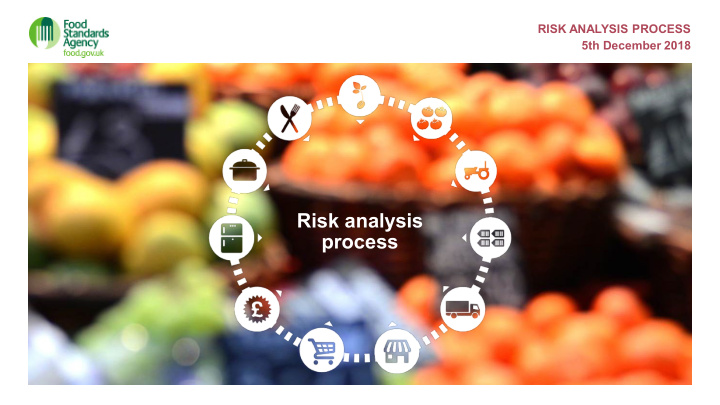



RISK ANALYSIS PROCESS 5th December 2018 Risk analysis process
Outline • The aim of this presentation is to take the Board through the FSA risk analysis process. • Risk analysis is a process consisting of three components: risk assessment, risk management and risk communication. • The process is illustrated in a step by step flowchart.
Risk analysis The three components of risk analysis are defined as follows: Risk assessment: A scientifically based process consisting of the following steps: (i) hazard identification, (ii) hazard characterization, (iii) exposure assessment, and, (iv) risk characterization. Risk management: The process, distinct from risk assessment, of weighing policy alternatives, in consultation with all interested parties, considering risk assessment and other factors relevant for the health protection of consumers and for the promotion of fair trade practices, and, if needed, selecting appropriate prevention and control options. Risk communication: The interactive exchange of information and opinions throughout the risk analysis process concerning risk, risk-related factors and risk perceptions, among risk assessors, risk managers consumers, industry, the academic community and other interested parties, including the explanation of risk assessment findings and the basis of risk management decisions.
Step 1 : Potential risks identified by our surveillance capability and other sources are profiled and prioritised 1 2 3 Problem formulation Preliminary activities Risk Step 2 : Preliminary risk management to agree scope of risk to determine identificatio assessment and whether action activities will be carried out to n other evidence is appropriate required determine whether risk analysis is needed Step 3 : If Step 2 identifies the need for a new assessment of relevant evidence, the question(s) to be answered in relation to risk assessment and consumers’ other interests will be agreed between risk managers and risk assessors
5 4 Identification of Production of risk approaches to assessment and gather and analyse analysis of evidence evidence Step 4 : The scientific/analytical discipline(s), sources and approaches needed, and the experts best placed to gather and analyse the evidence is determined by risk assessors; timescales for delivery of the evidence are agreed with risk managers and risk communicators. Step 5 : The risk assessment and other evidence are produced and drawn together into an evidence package. Our scientific advisory committees will advise us in the assessment of toxicological and microbiological risks
Risk Analysis - Plans for FSA Scientific Advisory Committees 1. What we have now Risk based standards and controls Regulated products Bulk of FSA and SACs current work Risk assessment largely done at EFSA Risk assessment for EU and national level controls COT, ACMSF, COT, ACMSF ACNFP ACNFP ACAF RA Occasional review of Main work ad hoc National RAs Mix of EFSA RAs on limited RA, Technical number and TA Advice type of and relevant dossiers RM to RA Other advice for RM Key RA – risk assessment COT Committee on Toxicity TA – technical advice ACMSF Advisory Committee on Microbiological Safety of Food RM – risk management ACNFP Advisory Committee on Novel Foods & Processes FCM – food contact materials ACAF Advisory Committee on Animal Feedingstuffs
EU Exit: Plans for FSA Scientific Advisory Committees 2. What we are going to do for Day 1 Risk based standards and controls Regulated products RA for national controls, trade RA for national applications Review RA from EU/others Review RA from EU/others COT, ACMSF, ACAF: ACNFP COT, ACMSF – main work RA joint groups Novel food ACNFP, ACAF – as needed Food contact and feed materials (incl. GM) TA Additives relevant to RA Feed Other ACAF - other advice for risk ACAF - other advice for risk management advice feeds into new structures as they develop management feeds into new for RM structures as they develop Key RA – risk assessment COT Committee on Toxicity TA – technical advice ACMSF Advisory Committee on Microbiological Safety of Food RM – risk management ACNFP Advisory Committee on Novel Foods & Processes FCM – food contact materials ACAF Advisory Committee on Animal Feedingstuffs
6 Quality assurance by Chief Scientific Adviser and/or Scientific Advisory Committees 7 Risk assessment and other Step 6 : Quality will be assured by internal and external evidence experts, including the FSAs’ independent Scientific presented to risk Advisory Committees, Science Council and the CSA who managers has an overall independent assurance and challenge role Risk Step 7 : An evidence package containing the risk assessment assessment and information on other legitimate factors published evidence is presented to risk managers.
Step 8 : Risk managers will use evidence to develop, analyse and identify risk management 1 recommendations in consultation with other government departments and the Devolved Administrations. Opportunity for the Board to have an input into issues of strategic policy or complexity. Step 9 : The AFFF will consider all food and feed safety issues where a risk management recommendation is required from FSA. It will not consider risk management advice provided to support operational management of routine food incidents 8 9 10 12 11 Analysis of risk management FSA Advisory Risk managers FSA considers FSA consult Board options based on Forum on Food develop advice Board if necessary risk assessment and Feed based on available recommendations and other evidence and AFF where appropriate legitimate factors opinion and finalises advice Step 10 : e.g. outputs of the risk analysis process will in general be advice on risk-based standards and Formal Forum Publish FSA consultation controls to ensure food remains safe, and pre-market approvals and authorisations opinion advice with as supporting published necessary evidence Step 11 : Opportunity for the Board to have an input into issues of strategic policy or complexity Step 12 : Final advice will be presented to ministers.
Recommend
More recommend